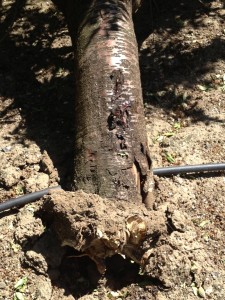Current forecasts call for another windstorm throughout the San Joaquin Valley. This is coming after several windy days experienced earlier last week. High winds can cause tree loss within orchards, especially within older blocks.

There is two types of tree losses experienced from high winds: wind-throw and tree loss from wood decay fungi. Wind-throw occurs when the velocity of wind able to exert enough force to break major roots, causing the tree to fall over. This occurs frequently on younger trees that are heavy with crop or when high winds are experienced along with saturated soil conditions. Tree loss to wood decay fungi typically occurs in older orchards, usually 8 years or older. In these cases, these fungi, which typically degrade lignin, invade the heartwood of the tree, breaking down the plant’s tissues. Once enough of the tissue has been broken down, the tree loses structural integrity and falls over when enough force is received.
To tell the difference between the two, look at the tree. Trees infected with wood-decay fungi often break off at the ground level and “dry-rotted” wood is observed in the center of the tree. In some cases, white fungal growth (or mycelium) can be observed within the inner tissues, and conks can be observed growing on the outside of the trunk. Wind-thrown trees have a different look – trees often do not break off at the ground level, but rather uproot and pull up soil.
It is important to note that wood decay fungi are secondary pathogens and rely on some type of injury to gain access. These injuries include crown gall infections, Ceratocystis cankers, shaker damage, Phytophthora infections, large pruning wounds (and associated cankers), and herbicides applied to the trunk of the tree. Initial infection occurs relatively early in the tree’s life, but will take 5 or more years for the tree to blow over. Practices, therefore, must be in use throughout the entirety of the orchard’s life – with emphasis on the younger years.
To prevent wind-throw, practices must be applied at the layout and planting of the orchard. Avoid planting high on berms that are perpendicular to prevailing winds. Orient strong roots in the direction of the prevailing wind, and design the irrigation system to ensure a wetting pattern that will favor good root distribution. Avoid heading trees too high, which can favor a top-heavy tree. Select varieties that are less upright, and plan to defoliate the trees with zinc sulfate prior to any winter storms to reduce wind resistance.


Harneet Gill
April 16, 2013Very good info. What is your estimate of the percentage of trees that fall due to wood decay?
David Doll
April 16, 2013Field observations from the Sacramento Valley have shown that as trees age, more loss is due to wood decay fungi. Eight year old trees that blew over had a 60/40% split of loss due to wood decay fungi/wind-throw. In a 15 year old orchard, losses due to wood decay fungi increased, affecting around 75% of observed old blown over trees, and in 19 year old orchards, around 90%. In trees less than 8 years old – losses are more likely due to wind-throw since limited time has prevented the widespread growth/invasion of the heartwood by the wood decay fungi.
Within Merced County, the symptoms observed in the Sacramento valley appear to hold true. Many orchards that are aged 10 years or older tend to have tree loss due to wood decay fungi. In some orchards, every tree that I observed blown over had clear signs of wood decay. Mature, flood irrigated blocks on very sandy soil may still experience wind-throw, and irrigation should be applied when high winds are not forecasted.